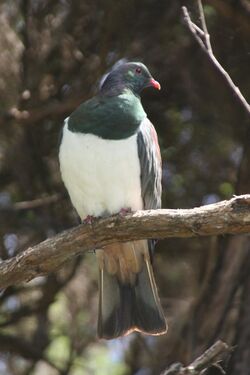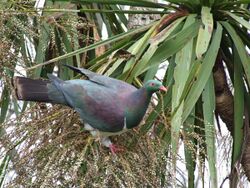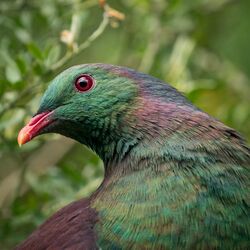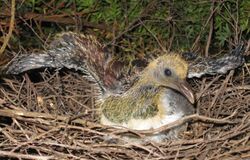Biology:New Zealand pigeon
| New Zealand pigeon | |
|---|---|

| |
| On Kapiti Island, New Zealand | |
| Scientific classification | |
| Domain: | Eukaryota |
| Kingdom: | Animalia |
| Phylum: | Chordata |
| Class: | Aves |
| Order: | Columbiformes |
| Family: | Columbidae |
| Genus: | Hemiphaga |
| Species: | H. novaeseelandiae
|
| Binomial name | |
| Hemiphaga novaeseelandiae (Gmelin, 1789)
| |
The New Zealand pigeon or kereru (Māori: kererū; Hemiphaga novaeseelandiae) is a bird endemic to New Zealand. Māori call it kererū in most of the country but kūkupa and kūkū in some parts of the North Island, particularly in Northland. Commonly called wood pigeon,[2] they are distinct from the wood pigeon (Columba palumbus) of the Northern Hemisphere, which is a member of a different genus.
The New Zealand pigeon belongs to the family Columbidae, and the subfamily Ptilinopinae, which is found throughout Southeast Asia, Malaya, Australia and New Zealand. The members of this subfamily feed largely on fruits, mainly drupes.[3] New Zealand pigeons are members of the pigeon genus Hemiphaga (Bonaparte, 1854), which is endemic to the New Zealand archipelago and Norfolk Island. However recently a Hemiphaga bone was found on Raoul Island.[4] The Chatham pigeon or Chatham Island pigeon (Hemiphaga chathamensis) is traditionally considered a subspecies of the kereru, but is here treated as a separate species.
Description
The New Zealand pigeon is a large, 550–850 grams (19–30 oz), arboreal fruit-pigeon[5] found in forests from Northland to Stewart Island/Rakiura, ranging in habitats from coastal to montane.[6] The general morphology is that of a typical pigeon, in that it has a relatively small head, a straight soft-based bill and loosely attached feathers. It also displays typical pigeon behaviour, which includes drinking by suction, a wing-threat display, hitting with the wing when threatened, a diving display flight, a 'bowing' display, ritualised preening and 'billing' during courtship. New Zealand pigeons build flimsy, shallow, twiggy nests and feed crop milk to hatchlings.[3][7]
The mainland New Zealand pigeon grows to some 51 centimetres (20 in) in length and 650 grams (23 oz) in weight, compared to 55 centimetres (22 in) and 800 grams (28 oz) for the Chatham Island variant.[8] The head, throat and wings are generally a shiny green-purple colour, but with a bronze tinge to the feathers. The breast is typically white and the bill red with an orange-ish tip. The feet and eyes are red. Juveniles have a similar colouration but are generally paler with dull colours for the beak, eyes and feet and a shorter tail.
The New Zealand pigeons make occasional soft coo sounds (hence the onomatopoeic names), and their wings make a very distinctive "whooshing" sound as they fly. The bird's flight is also distinctive.[9] Birds will often ascend slowly before making impressively steep parabolic dives;[10] it is thought that this behaviour is often associated with nesting, or nest failure.[11]
Taxonomy
As generally accepted, there are three subspecies of New Zealand pigeon; of these, only two survive: H. n. novaseelandiae of mainland New Zealand and H. n. chathamensis of the Chatham Islands. The other subspecies, Norfolk pigeon (H. n. spadicea) of Norfolk Island, is now extinct. The subspecies differ in their plumage colour and physical morphology.[7]
In 2001, it was proposed that H. n. chathamensis, the Chatham pigeon, was distinct enough to be raised to full species status, H. chathamensis, instead of the traditional subspecies status, H. n. chathamensis.[12] Few authorities outside New Zealand have followed this, with most still considering it a subspecies.[13][14] However, the IUCN,[15] does, ranking it "Vulnerable".[16][17]
Behaviour
Diet

The New Zealand pigeons are commonly regarded as frugivorous, primarily eating fruits from native trees. They play an important ecological role, as they are the only birds capable of eating the largest native fruits and drupes (those with smallest diameter greater than 1 cm), such as those of the taraire, and thus spreading the seeds intact.[18] While fruit comprises the major part of their diets, the New Zealand pigeon also browses on leaves and buds, especially nitrogen rich foliage during breeding.
One of their favourite leaves to eat is from an introduced plant, the common plum tree. The diet changes seasonally as the availability of fruit changes, and leaves can comprise the major part of the diet at certain times of the year, such as when there is little fruit around.[19]
Breeding
Breeding generally depends on the availability of ripe fruit, which varies seasonally, annually (good years and bad years), and by location. New Zealand pigeons, like other frugivorous pigeons, feed on many species with tropical affinities, including the Lauraceae and Arecaceae,[20][21][22][23] which abound in the essentially subtropical forests of northern New Zealand. They also feed on podocarp species, thought to be relics of the flora of Gondwana, such as miro (Prumnopitys ferruginea) and kahikatea (Dacrycarpus dacrydioides).[21][22][23][24] In the warmer northern half of the North Island, pigeons can nest all year round, except when moulting between March and May, provided enough fruit is available.[18] Further south fewer subtropical tree species grow and in these areas breeding usually occurs between October (early spring) and April (late summer/early autumn), again depending on fruit availability.
New Zealand pigeons nest in trees, laying a single egg, in a flimsy nest constructed of a few twigs thrown together. The egg is incubated for 28–29 days and the young bird takes another 30–45 days to fledge.[25] In seasons of plentiful fruit the pigeons can successfully nest up to four times.
Distribution and conservation
The population of the New Zealand pigeon declined considerably after the arrival of humans in New Zealand, and this trend continues, especially in the North Island, but they are still relatively common in the west of the South Island and in coastal Otago. They are commonly found in native laurel forests (lowlands in particular), scrub, rural and city gardens and parks.[26]
The introduced Australian common brushtail possum (Trichosurus vulpecula) and introduced species of rats – mainly the ship or black rat (Rattus rattus) but also the kiore or Polynesian rat (Rattus exulans) and brown rat (Rattus norvegicus) – have significantly reduced the amount of fruit available for pigeons and other native birds and also prey on eggs and nestlings.[27]
Pigeon populations are also under threat from hunting, habitat degradation and poor reproductive success.[25][28][29] Pigeons were very numerous until about the 1860s and large flocks used to congregate in fruiting trees to feed.[30] Restrictions on the shooting of pigeons were enacted as early as 1864, with total protection since 1921,[3] although the enforcement against hunting was not consistent. Some Māori protested, claiming a traditional right to hunt the pigeon.[31]
The bird is protected under the Wildlife Act and there have been prosecutions for shooting it.[32]
See also
- Birds of New Zealand
- Chatham pigeon
References
- ↑ BirdLife International (2016). "Hemiphaga novaeseelandiae". IUCN Red List of Threatened Species 2016: e.T22727557A94952579. doi:10.2305/IUCN.UK.2016-3.RLTS.T22727557A94952579.en. https://www.iucnredlist.org/species/22727557/94952579.
- ↑ "Drunk kereru fall from trees", Feb 22, 2013, Laura Mills & Kurt Bayer, nzherald.co.nz
- ↑ 3.0 3.1 3.2 Falla, R. A., R. B. Sibson, and E. G. Turbott (1979). The new guide to the birds of New Zealand and outlying islands. Collins, Auckland.
- ↑ Worthy, T. H., and R. Brassey. (2000). New Zealand pigeon (Hemiphaga novaeseelandiae) on Raoul Island, Kermadec Group. Notornis 47 (1): 36–38
- ↑ Clout, M. (1990). The Kereru and its forests. Birds International 2:10–19.
- ↑ Clout, M. N., P. D. Gaze, J. R. Hay, and B. J. Karl. (1986) Habitat use and spring movements of New Zealand pigeons at Lake Rotoroa, Nelson Lakes National Park. Notornis 33:37–44.
- ↑ 7.0 7.1 James, R. E. (1995). Breeding ecology of the New Zealand pigeon at Wenderholm Regional Park. p93. School of Environmental and Marine Science. University of Auckland, Auckland.
- ↑ Robertson, Hugh, and Barrie Heather. 1999. The Hand Guide to the Birds of New Zealand. Penguin Books. ISBN:0-19-850831-X
- ↑ Daglish, Lisa. City Pigeons:Kereru (Hemiphaga novaeseelandiae) in the Urban Dunedin Environment: Abundance, Habitat Selection and Rehabilitation Outcomes (PDF) (MSc). University of Otago. Retrieved 18 May 2019.
- ↑ Robertson, Hugh A. (2001). The hand guide to the birds of New Zealand. Heather, B. D. (Barrie D.), Onley, Derek J.. Oxford: Oxford University Press. pp. 134. ISBN 019850831X. OCLC 45015387. https://www.worldcat.org/oclc/45015387.
- ↑ "Kereru" (in en-US). 2011-08-24. https://birdrescue.org.nz/kereru/.
- ↑ Millener, P. R., and R. G. Powlesland. (2001). The Chatham Island pigeon (Chatham pigeon) deserves full species status; Hemiphaga chathamensis (Rothschild 1891); Aves: Columbidae. Journal of the Royal Society of New Zealand 31:365–383.
- ↑ Clements, J. (2007). The Clements Checklist of the Birds of the World. Edition 6. Christopher Helm. ISBN:978-0-7136-8695-1
- ↑ Dickinson, E. (2003). The Howard and Moore Complete Checklist of the Birds of the World. Edition 3. Christopher Helm. ISBN:0-7136-6536-X
- ↑ BirdLife International (2014). "Hemiphaga chathamensis". IUCN Red List of Threatened Species 2014. https://www.iucnredlist.org/details/22732918/0. Retrieved 5 August 2015.
- ↑ Miskelly, C.M.; Dowding, J.E.; Elliot, G.P.; Hitchmough, R.A.; Powlesland, R.G.; Robertson, H.A.; Sagar, P.M.; Scofield, R.P. et al. (2008). "Conservation status of New Zealand birds". Notornis 55 (3): 117–135. http://notornis.osnz.org.nz/conservation-status-new-zealand-birds-2008. Retrieved 20 May 2012.
- ↑ "Facts about Chatham Island pigeon". Department of Conservation. http://www.doc.govt.nz/conservation/native-animals/birds/land-birds/chatham-island-pigeon-parea/facts/. Retrieved 20 May 2012.
- ↑ 18.0 18.1 Christine Mander, Rod Hay and Ralph Powlesland. (1998) Monitoring and management of kereru (Hemiphaga novaeseelandiae), Department of Conservation technical series (ISSN 1172-6873), number 15. Department of Conservation, Wellington, New Zealand. ISBN:0-478-21751-X. Accessed 2008-01-13.
- ↑ O'Donnel, C & P. Dilks (1994) "Foods and foraging of forest birds in temperate rainforest, South Westland, New Zealand" New Zealand Journal of Ecology 18(2): 87–107. [1]
- ↑ Bell, R. (1996). Seed dispersal by kereru (Hemiphaga novaseelandiae) at Wenderholm Regional Park. p87. School of Biological Sciences. University of Auckland, Auckland.
- ↑ 21.0 21.1 Clout, M. N., and J. R. Hay. (1989) The importance of birds as browsers, pollinators and seed dispersers in New Zealand forests. New Zealand Journal of Ecology 12:27–33.
- ↑ 22.0 22.1 Clout, M. N., B. J. Karl, and P. D. Gaze. (1991). Seasonal movements of New Zealand pigeons from a lowland forest reserve. Notornis 38:37–47.
- ↑ 23.0 23.1 McEwen, W. M. 1978. The food of the New Zealand pigeon (Hemiphaga novaeseelandiae). New Zealand Journal of Ecology 1:99–108,
- ↑ Clout, M. N., and J. A. V. Tilley. (1992) Germination of miro (Prumnopitys ferruginea) seeds after consumption by New Zealand pigeons (Hemiphaga novaeseelandiae). New Zealand Journal of Ecology 30:25–28.
- ↑ 25.0 25.1 Clout, M. N., K. Denyer, R. E. James, and I. G. Mcfadden. (1995) Breeding success of New Zealand pigeons (Hemiphaga novaeseelandiae) in relation to control of introduced mammals. New Zealand Journal of Ecology:209–212.
- ↑ "Kererū begin winter wandering". Christchurch City Council. 16 May 2017. https://ccc.govt.nz/news-and-events/newsline/show/1677. Retrieved 3 August 2018.
- ↑ Mander, Christine. "Monitoring and management of kereru". https://www.doc.govt.nz/Documents/science-and-technical/docts15.pdf. Retrieved 3 August 2018.
- ↑ Clout, M. N., B. J. Karl, R. J. Pierce, and H. A. Robertson. (1995) Breeding and survival of New-Zealand pigeons Hemiphaga novaeseelandiae. Ibis 137:264–271.
- ↑ Clout, M. N., and A. J. Saunders. (1995) Conservation and ecological restoration in New Zealand. Pacific Conservation Biology 2:91–98.
- ↑ Best, E. (1977). Forest lore of the Maori. E.C. Keating Government Printer, Wellington, New Zealand.
- ↑ Feldman, James W. (2001). "Enforcement, 1922–60 ", chapter 3 Treaty Rights and Pigeon Poaching: Alienation of Maori Access to Kereru, 1864–1960. Waitangi Tribunal, Wellington, New Zealand. ISBN:0-908810-55-5
- ↑ Telfer, Ian (11 August 2016). "Sonny Tau fined $24,500 over dead kereru case". https://www.radionz.co.nz/news/national/310714/sonny-tau-fined-$24,500-over-dead-kereru-case. Retrieved 3 August 2018.
Further reading
- Dijkgraaf, Astrid Cora. 2002. Phenology and frugivory of large-fruited species in northern New Zealand and the impacts of introduced mammals. PhD Thesis, School of Biological Sciences. University of Auckland, Auckland.
External links
| Wikimedia Commons has media related to Hemiphaga novaeseelandiae. |
- Wood pigeon/kereru: New Zealand Native land birds from the Department of Conservation
- The Kereru Discovery Project, a programme for New Zealanders to help arrest the decline of the species through awareness and action in their own gardens
- Kereru, the New Zealand pigeon, Gallery of New Zealand Birds, New Zealand Birds Ltd.
Wikidata ☰ Q1145127 entry






